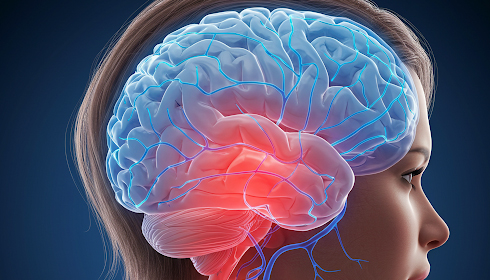
New Study Uncovers Sex-Specific Pain Relief Mechanism in Women
A groundbreaking study from UC San Francisco has uncovered a unique mechanism by which female hormones use immune cells to alleviate chronic pain, potentially leading to new treatment options. On April 4, a study in Science revealed the role of oestrogen and progesterone in stimulating T regulatory immune cells (T-regs) located near the spinal cord to generate pain-relieving opioids, thereby preventing pain signals from reaching the brain. This finding provides promising insights for improved pain management and reveals the reasons behind the varying effectiveness of certain painkillers in women, as well as the increased pain experiences often reported by postmenopausal women.
The research, partially supported by the National Institutes of Health, examined T-regs found in the meninges, which are the protective layers encasing the brain and spinal cord. In the past, it was believed that the meninges served only to protect the central nervous system and facilitate waste removal. Recent findings have revealed the presence of T-regs in this region, shedding light on their surprising role in the modulation of pain. “Our findings reveal that the immune system uses the meninges to relay information to distant neurones responsible for sensing stimuli on the skin,” stated Sakeen Kashem, MD, PhD, an assistant professor of dermatology and co-lead author of the study. “This is information that was previously unknown to us.”
The team of researchers carried out experiments involving mice, concentrating on T-regulatory cells located in the meninges surrounding the lower spinal cord. The removal of these cells through toxin application yielded remarkable results: female mice exhibited a notable increase in pain sensitivity, whereas male mice remained unaffected. This response, which is specific to sex, suggests that female mice—and possibly women—depend more significantly on T-regs for alleviating pain. “It was intriguing yet perplexing,” Kashem remarked. “It genuinely caused me to question things at first.”
Additional inquiry uncovered that in female mice, oestrogen and progesterone activate T-regs to generate enkephalin, a natural analgesic. “It’s quite unusual that there’s a sex-dependent influence on these cells, driven by oestrogen and progesterone, which is completely unrelated to any immune function,” remarked Elora Midavaine, PhD, a postdoctoral fellow and the study’s first author. This discovery may shed light on the reasons behind the heightened effectiveness of specific pain relievers, like those for migraines, in women, alongside the higher incidence of pain observed in postmenopausal women, who have ceased hormone production.
The data clearly highlights the pressing need for this research. The Centres for Disease Control and Prevention (CDC) reports that in 2021, around 20.9% of adults in the U.S.—more than 50 million individuals—suffered from chronic pain, with women indicating higher prevalence than men. A study conducted in 2023 and published in Pain Medicine reveals that women experience chronic pain conditions at a rate 1.5 times higher than men, with these issues frequently worsening post-menopause as a result of hormonal shifts. Insights from the UCSF study regarding T-Regs and female hormones may pave the way for personalised treatments, especially for women after menopause.
The researchers are currently investigating the potential to engineer T-regs for consistent enkephalin production across both sexes. “Should this method prove effective, it has the potential to significantly transform the lives of the approximately 20% of Americans suffering from chronic pain that remains insufficiently addressed,” stated Allan Basbaum, PhD, who co-led the research alongside Kashem.
This finding represents a significant advancement in our understanding of the biological foundations of sex differences in pain management, offering hope to numerous individuals suffering from chronic pain. The result highlights the importance of tailored medical approaches, particularly for women facing the complexities of menopause. The path from laboratory discoveries to clinical application is extensive, necessitating additional research to evaluate the potential risks associated with immune cell manipulation. It is essential for society to address the wider challenge of disparities in pain treatment, guaranteeing fair access to new therapies that are emerging in the field.